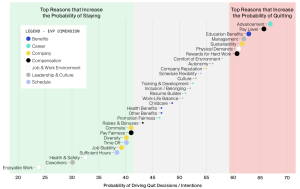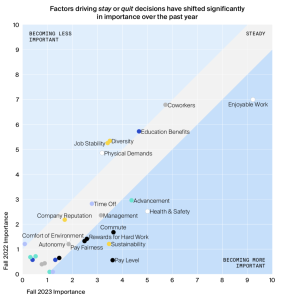It’s staggering to think that despite the much commented death of the high streets, retail still accounts for 26% of all US employment (source: National Retail Federation).
But not only have retail employers always faced a shifting landscape when it comes to hiring the right talent at the right time, the past few years’ macroeconomic turmoil coming out of the pandemic has rocked the retail labor environment to its core.
Organized retail crime has gained attention in the media, and shrinkage (loss to even garden-variety shoplifting and theft), tallied up to $112 billion in 2022.
Hourly pay rates changed significantly in the last 18 months, accounting for significant shifts in workplace attitudes. Simultaneously, inflation changed consumers’ attitudes while expectations for the in-store experience remained high.
All of this adds up to changing attitudes for retail associates, the mainstay of the in-store experience.
And for retail employers, retaining good staff has become more important in the post-Covid age of work flexibility.
So what do all these macro trends mean in terms of what CHROs need to do from a talent planning perspective?
The desire from employers for workers to want to stay (and have fewer employees that want to quit), is the basic requirement.
To answer what needs to happen to achieve this, we recently conducted a longitudinal study to help employers understand the job factors that affect retail associates’ retention decisions – factors that have shifted in importance even in the 18 months during which we conducted this study.
Overall, we found employers are faced with a delicate balancing act.
Several aspects of the job influence decisions to quit or stay

To help understand the specifics, we ran three iterative surveys, sampling more than 3,000 retail workers across 700 retailers over a period of 18 months – the most robust independent polling of retail workers to date.
We identified 30 different job factors across seven critical dimensions of the Employee Value Proposition (EVP), which allowed us to track and analyze changes in attitudes toward these factors among employees who choose to stay, consider quitting, or actually quit their retail jobs.
The granularity of this exercise allowed us to see some surprising changes, even in a relatively short period, and the resulting algorithm from the most recent sample alone can predict whether retail associates are likely to stay at or quit their jobs with 87% accuracy.
This exercise showed us that, psychologically, the job factors that affect staying behaviors are different than those that affect quitting behaviors.
One can think of this like magnetism.
Certain factors attract and build loyalty among retail associates while others repel and drive turnover.
Understanding employees’ expectations and incentivizing areas – the factors that keep associates in their jobs – is just as important as mitigating those factors that cause them to quit.
On top of this, retail employers need to develop a talent strategy that accounts for continual changes in labor and market conditions.
Retail employees are more likely to stay, but pay is becoming much more important
Our research showed that over the period from Summer 2022 to Holiday 2023, fewer people left their positions.
In the first round of our research in 2022, 60% of surveyed retail associates were content to stay in their job, and by the end of 2023, this had risen to 68%.
BUT – while there are fewer people quitting their retail jobs, there are more that are contemplating quitting.
In Summer 2022, 26% of our survey respondents had left their job and 14% were considering quitting.
By the Holiday 2023 season, our most recent survey, only 11% of respondents had quit, while 21% were considering quitting.

What might explain this? Well, with the reduction we’ve seen in salary volatility, the demand for labor is decreasing. Nonetheless, even with ongoing wage growth, associates are experiencing a decline in available work hours – making efforts to increase pay moot.
These changes are influencing the attitudes of the retail workforce: over the last 12 months, factor of low pay increased more than any other in predicting quit decisions.
Low pay now sits just behind lack of job advancement opportunities as the top driver of quitting decisions.
Other “quit” factors include lack of education benefits, disliking management, and poor sustainability practices.
Over the course of the study, two factors – feeling workplace health & safety is valued and finding the work enjoyable – have both increased dramatically in their predictive power to become among the top three predictive factors of retention, with the third factor being positive relationships with co-workers.
For the health and safety factor, though, the pandemic may be less indicative of attitudes now.
The risks posed by the rise in in-store theft, mentioned earlier, are making a safe workplace a top priority for associates.
Other “stay” factors include perceiving job stability, being scheduled sufficient hours, and having the ability to take time off.
Lack of schedule flexibility can act as a triggers that Leads to turnover intentions


This study revealed certain magnetic forces that uniquely attract or repel associates.
But there was one job factor that was more predictive of the “in-between” state of considering quitting: schedule flexibility.
Schedule flexibility, or lack thereof, acted as a “trigger” to turnover.
Retail associates who would otherwise stay in their jobs are likely to become disengaged or have “one foot out the door” as soon as the flexibility of their schedule is challenged.
Retail employers must therefore set clear expectations about scheduling while creating sufficient flexibility so that staffing issues don’t erupt at peak times.
Overall thoughts
From our analysis, we suggest retailers need to understand, first, that it is not just the macroeconomic and cultural factors that affect their ability to attract and retain associates, but it is the psychology of retail associates and the shifts in their attitudes toward work and employers that matter just as much.
Retailers must therefore pay close attention to their employees’ experience so they can determine the offensive and defensive strategies that simultaneously work on unique retention and turnover drivers.
Secondly, any talent strategy is going to have a short shelf-life as the factors driving quit and stay decisions consistently shifted in importance over the last two years.
So strategies must evolve at the pace of changing preferences.
For the foreseeable future, though, employers should know that lack of advancement opportunities, low pay, and poor education benefits drive turnover.
Meanwhile, the top drivers of retention are providing an enjoyable, safe job with strong coworker relationships and sufficient hours.
